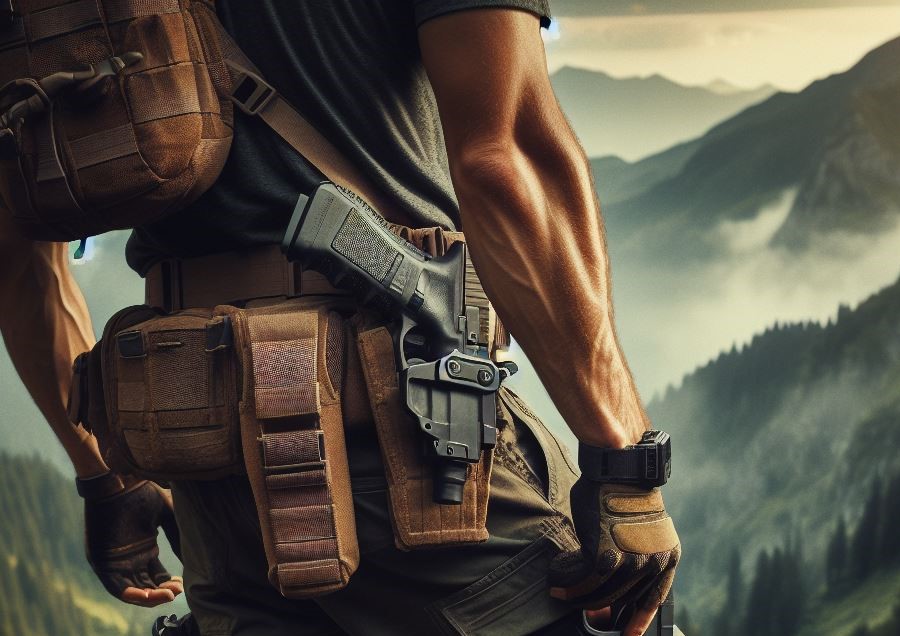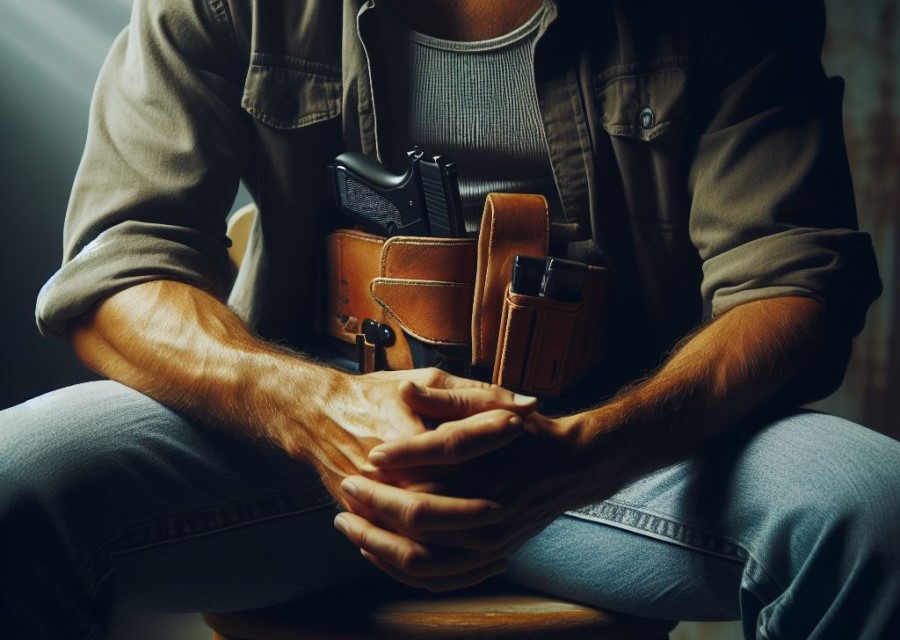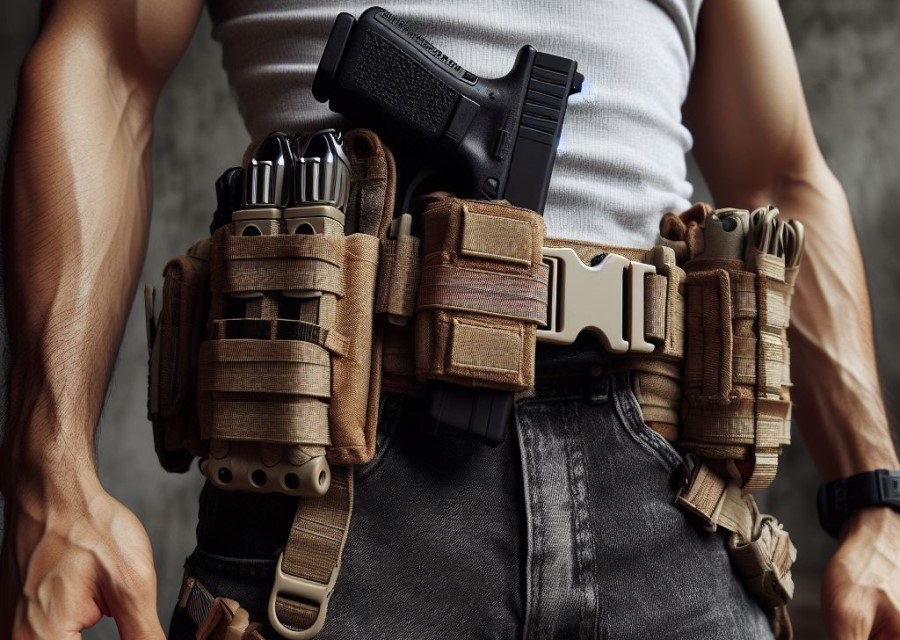Holsters are a crucial gear accessory for hikers, providing a safe and convenient way to carry firearms, knives, or other tools during outdoor adventures. Choosing the right holster for hiking is essential to ensure comfort, accessibility, and security.
When selecting a hiking holster, several factors need to be considered, such as comfort, accessibility, security, durability, and fit. Ensuring a holster meets these criteria will enhance your hiking experience and keep your essentials easily accessible.
Here are some top holster options for hiking: belt holsters, chest holsters, ankle holsters, shoulder holsters, waistband holsters, and pack holsters. Each type of holster has its own advantages and considerations. To help you choose the best holster for your hiking needs, factors like material, adjustability, concealment, and water resistance should also be taken into account.
There are tips to keep in mind when using holsters while hiking to maximize safety and functionality. By carefully considering these aspects and selecting the appropriate holster, hikers can optimize their outdoor experience and ensure their essential tools are within reach at all times.
Factors to Consider When Choosing a Hiking Holster

When it comes to choosing the perfect holster for your hiking adventures, several key factors should be taken into consideration.
In this section, we’ll explore the crucial elements that can make or break your hiking holster choice.
From comfort and accessibility to security, durability, and fit, we’ll uncover the factors that ensure a seamless and reliable hiking experience. So, let’s dive in and discover what makes the best holsters for hiking stand out from the rest!
1. Comfort
- When selecting a hiking holster, it is essential to prioritize comfort in order to have an enjoyable hiking experience.
- Ensure that the holsters you consider have padded straps or foam inserts to provide cushioning and prevent any discomfort.
- It is advisable to choose holsters made from breathable materials that enable air circulation and prevent the accumulation of sweat.
- Consider opting for holsters with adjustable straps or waistbands that can be personalized to fit your specific body shape and size, ensuring a snug and comfortable fit.
- Examine the holsters for ergonomic design characteristics that evenly distribute the weight of the holster across your body, so as to avoid any strain or pressure points.
- Take the opportunity to try out various holsters and assess how they feel when walking or hiking in order to discover the most comfortable option for you.
- Remember that comfort is subjective, so what may work for others may not necessarily work for you. Trust your own preferences for comfort when selecting a hiking holster.
2. Accessibility
When choosing a hiking holster, accessibility is a crucial factor to consider. It is important to have quick and easy access to your gear when you’re out on the trails. Here are some aspects of accessibility to keep in mind:
- Accessibility of pockets: Look for holsters that have multiple pockets or compartments that allow you to organize and access your items efficiently. Having designated spaces for essentials like a compass, map, or multitool can save time and prevent rummaging through your gear.
- Accessibility of weapons: If you’re carrying a weapon, ensure that the holster provides secure but quick access. Look for holsters with adjustable retention systems or quick-release mechanisms that allow for smooth drawing and reholstering without compromising safety.
- Accessibility on the body: Consider how the holster will be worn and how it will integrate with your hiking gear. Holsters that can be worn on the belt, chest, ankle, or shoulders offer different levels of accessibility. Choose a placement that aligns with your preferences and ease of use while hiking.
- Accessibility in different conditions: Think about the weather and terrain you’ll encounter on your hikes. Look for holsters that are water-resistant or have protective features to shield your gear from rain or accidental splashes. Additionally, consider how the holster will perform in varying temperatures or challenging environments.
- Accessibility for different activities: If you plan to engage in activities like climbing or backpacking, choose a holster that won’t hinder your movement or create discomfort. Opt for holsters that are designed to stay securely in place and provide easy access to your essentials while maintaining stability.
By considering the accessibility of a hiking holster, you can ensure that your gear is readily available when you need it, allowing you to focus on enjoying your outdoor adventures.
3. Security
When it comes to choosing a hiking holster, security is a crucial factor to consider. The safety and protection of your gear should always be a priority while enjoying outdoor activities. Here are some key points to keep in mind:
- Durable construction: Look for holsters made from high-quality materials such as nylon or Kydex. These materials offer excellent durability and resistance to wear and tear.
- Secure closures: Opt for holsters with secure closures like snap buttons or adjustable straps. This will ensure that your gear stays securely in place, even during rigorous hiking activities.
- Retention system: Consider holsters with a reliable retention system, such as adjustable retention screws or friction fit. This will prevent your gear from accidentally falling out or shifting around while on the move.
- Concealment capabilities: If you value discreetness, choose a holster that offers good concealment. Look for options with adjustable cant or those designed to sit close to your body for minimal printing and visibility.
- Compatibility: Make sure the holster is compatible with your specific gear, such as the size and model of your firearm or knife. A properly fitting holster will provide better security and accessibility.
Pro-tip: Regularly inspect your holster for any signs of wear or damage. Replace any worn-out components to maintain optimal security and protection for your gear.
4. Durability
Durability is a crucial factor to consider when choosing a hiking holster. It ensures that the holster can withstand the rugged conditions and demands of outdoor activities. To evaluate the durability of a holster, several aspects should be taken into account.
First and foremost, the material used in the construction of the holster greatly influences its durability. A sturdy and high-quality material, such as reinforced nylon or durable leather, ensures that the holster can withstand frequent use and exposure to the elements.
The adjustability of the holster is also essential for its durability. A holster with adjustable straps or retention systems allows for a secure and snug fit, minimizing the risk of the holster coming loose or getting damaged during hiking.
Additionally, the overall construction and craftsmanship of the holster play a significant role in its durability. Look for reinforced stitching, reinforced edges, and quality hardware like heavy-duty buckles and snaps. These features contribute to the holster’s ability to withstand wear and tear over time.
Lastly, water resistance is an important aspect of durability, especially when hiking in wet or unpredictable weather conditions. A water-resistant or waterproof holster ensures that your gear remains protected, even in rainy or damp environments.
By considering these factors, you can choose a hiking holster that offers exceptional durability and reliability, ensuring that it will stand the test of time during your outdoor adventures.
5. Fit
When considering the fit of a hiking holster, there are several important factors to keep in mind:
- Size: The holster should be the right size to securely hold your firearm. It should have a snug fit to prevent any movement or sliding.
- Adjustability: Look for a holster that offers adjustable straps or fasteners. This allows you to customize the fit and ensure a comfortable and secure fit for your body.
- Comfort: The holster should be designed with padding or cushioning in key areas to prevent discomfort or irritation during long hikes. It should also have smooth edges to avoid rubbing against the skin.
- Mobility: The holster should not restrict your movement or hinder your ability to hike. It should allow for easy access to your firearm while still maintaining a secure fit.
- Retention: The holster should have a reliable retention system that keeps the firearm securely in place. It should provide a level of retention that gives you peace of mind while hiking.
By considering these factors, you can find a hiking holster that offers a proper fit and meets your needs for comfort, mobility, and firearm retention.
Top Holster Options for Hiking

Looking for the perfect holster for your hiking adventures? Look no further! In this section, we’ll explore the top holster options that are tailor-made for hiking.
From belt holsters to chest holsters, ankle holsters to shoulder holsters, waistband holsters to pack holsters, we’ve got you covered.
Whether you need quick and easy accessibility or prefer a more secure carry, we’ll help you find the ideal holster to keep your gear within reach while you conquer the trails.
1. Belt Holsters
Belt holsters are a versatile option for hikers as they can be worn on the waist or attached to backpacks for convenience.
They are a popular choice for hikers because they offer easy accessibility to your firearm.
These holsters are designed to securely attach to your belt, keeping your weapon within reach at all times.
They typically have adjustable straps or clips that allow you to adjust the fit for maximum comfort.
When selecting a belt holster, it is important to consider the material used. Look for durable, water-resistant materials that can withstand the rigors of outdoor activities.
Additionally, consider the level of concealment offered by the holster. It should provide sufficient coverage to keep your firearm hidden but still easily accessible.
Fact: Belt holsters are a versatile option for hikers as they can be worn on the waist or attached to backpacks for convenience.
2. Chest Holsters
When going hiking, a chest holster is a convenient and accessible option for carrying your firearm. These holsters are designed to be worn on the chest, allowing for easy access when needed. One of the key advantages of chest holsters is their comfort and stability, as they evenly distribute the weight of the firearm across the chest.
With a chest holster, accessibility is a top priority. The position of the firearm in front of you ensures that it is within easy reach and can be quickly drawn if necessary. Additionally, chest holsters provide a high level of security by securely holding the firearm in place, preventing accidental falls or unauthorized access.
Durability is another essential factor to consider when selecting a chest holster for hiking. It is crucial to choose a holster made from high-quality materials that can withstand the demands of outdoor activities.
When purchasing a chest holster, make sure it fits comfortably and securely. Take the time to try it on and adjust it according to your body shape and size. Some popular brands for chest holsters include Blackhawk, Safariland, and Condor, which offer a variety of styles and features to suit different preferences.
Remember that the best chest holster for hiking may vary depending on your specific needs and preferences. To find the perfect one for you, it’s important to do thorough research and try out different options.
3. Ankle Holsters
- Ankle holsters are a popular choice for hikers due to their convenience and accessibility.
- They provide a secure and discreet way to carry a small firearm.
- Ankle holsters, also known as ankle gun holsters, are specifically designed to fit comfortably around the ankle, offering flexibility and freedom of movement.
- They are typically made from durable materials such as nylon or leather, ensuring longevity.
- When choosing an ankle holster, it is important to consider the fit to ensure it stays in place during strenuous activities.
- Ankle holsters are ideal for carrying small or compact handguns.
- They can easily be concealed under pants or hiking boots for added security.
- Water resistance is an important factor to consider when purchasing an ankle holster for hiking, as it will protect your firearm from moisture damage.
- While ankle holsters may not be suitable for everyone, they offer a practical solution for hikers who want quick access to their firearms.
- It is important to follow local laws and regulations regarding the use and carry of firearms while hiking.
4. Shoulder Holsters
- Comfort: When choosing shoulder holsters, it is important to look for designs that incorporate padded straps or harnesses for optimal comfort during long hikes. Additionally, the material used should be breathable and lightweight to prevent excessive sweating.
- Accessibility: It is essential to select shoulder holsters that offer quick and easy access to your firearm. These holsters should have adjustable straps that keep the holster in the correct position for a smooth draw.
- Security: Prioritize shoulder holsters that securely hold your firearm in place, preventing any accidental slips or falls. Look for holsters with adjustable retention systems or straps to ensure a secure fit.
- Durability: Ensure that the shoulder holsters you consider are made from high-quality materials that can withstand the challenges of hiking. Look for options with reinforced stitching and durable hardware to guarantee long-lasting performance.
- Fit: When choosing a shoulder holster, finding the right fit is paramount. Look for adjustable straps or harnesses that can be customized to your body size and shape. It is crucial to try the holster with your firearm to ensure a snug and secure fit.
Pro-tip: While hiking with a shoulder holster, make sure to adjust the straps for proper weight distribution and comfort. Additionally, consider layering your clothing to prevent any discomfort caused by friction between your skin and the holster.
5. Waistband Holsters
When it comes to choosing the right waistband holsters for hiking, there are some important factors to keep in mind:
- Comfort: Waistband holsters should provide comfort, especially for long periods of time. It is beneficial to look for holsters with cushioning or padding to prevent discomfort.
- Accessibility: It is crucial that the waistband holster allows for easy and quick access to your firearm. Consider options that enable a smooth draw and re-holstering.
- Security: The waistband holster should securely hold your firearm in place to prevent any accidental or unauthorized access.
- Durability: It is important for the waistband holster to be made of high-quality materials that can withstand the rigors of hiking, such as moisture, abrasions, and impacts.
- Fit: The waistband holster should securely fit your firearm, ensuring it remains in place during your hike.
6. Pack Holsters
When it comes to pack holsters for hiking, there are several important factors to consider.
- Size: Pack holsters should be compact and lightweight to ensure easy portability during your hike.
- Accessibility: Look for a pack holster that allows quick and easy access to your firearm or other essentials, while still keeping them securely in place.
- Durability: Hiking can be rough on equipment, so choose a pack holster made from high-quality materials that can withstand the elements and rugged terrain.
- Comfort: Since you’ll be carrying the pack holster for extended periods, it’s crucial to find one that offers adjustable straps and padding for optimal comfort.
- Security: Your pack holster should have a reliable retention system to prevent your firearm or gear from accidentally falling out while you’re on the move.
When selecting a pack holster for hiking, it’s important to consider your specific needs and preferences. Some popular options include lightweight waist pack holsters or modular backpack holsters that can be attached to your hiking pack.
Remember, safety should always be the top priority when using any type of holster, so choose one that securely holds your firearm and allows for safe and easy access. Finding the right pack holster will greatly enhance your hiking experience by providing convenience, comfort, and peace of mind.
Comparison of the Best Hiking Holsters

When it comes to finding the perfect holster for hiking, it’s crucial to consider a few key aspects.
In this section, we’ll dive into the comparison of the best hiking holsters, exploring the material options, adjustability features, concealment capabilities, and water resistance of each.
So, stay tuned to discover the top-notch choices that prioritize comfort, practicality, and security, ensuring an optimal hiking experience.
Your holster search ends here!
1. Material
The material of a hiking holster plays a crucial role in its performance and durability. Different materials offer varying levels of strength, comfort, and weather resistance. When choosing a hiking holster, it is important to consider the material used in its construction.
Nylon is a popular choice for its strength and water resistance, making it suitable for various hiking conditions.
Kydex offers exceptional strength and comfort, along with complete waterproof protection.
Leather provides a classic look and good durability, but it requires maintenance to remain water-resistant.
Polymer is another durable option with good water resistance.
Consider the hiking conditions and personal preferences when selecting the material for your holster. For wet environments, a waterproof material like Kydex is highly recommended.
If comfort is a priority, leather or nylon can be a good choice. Assess the trade-offs between strength, comfort, and weather resistance to find the material that best suits your needs.
2. Adjustability
Adjustability is a crucial factor to take into account when selecting a hiking holster. When it comes to adjustability, there are several key aspects that should be considered:
- Strap length: It is important to choose a holster with adjustable straps so that the fit can be customized to your body. This will ensure that the holster remains securely in place throughout your hike.
- Belt size: If you prefer a holster that attaches to your belt, make sure it has an adjustable belt loop or clip that can accommodate different belt sizes. This will guarantee a snug and secure fit.
- Retention system: An adjustable retention system is essential for keeping your hiking holster securely in place. Look for options with adjustable tension screws or straps that can fit various firearm sizes and shapes.
- Attachment points: Some holsters have multiple attachment points, allowing you to adjust the positioning and orientation of the holster according to your preference.
- Comfort features: Take into consideration adjustable padding or cushioning in the holster to enhance comfort during long hikes.
By taking these aspects of adjustability into consideration, you will be able to find a hiking holster that offers a secure and comfortable fit tailored to your specific needs.
3. Concealment
- When choosing a holster, it is important to prioritize effective concealment. Your firearm should be securely held in the holster to prevent any printing or visibility to others.
- Take into consideration the design of the holster. Look for features such as adjustable retention and a snug fit to ensure proper concealment.
- For better concealment, opt for holsters made from materials like Kydex or leather, as they help minimize the outline of your firearm.
- Consider the placement of the holster and choose options like waistband or ankle holsters that offer superior concealment.
- Before making a final decision, test the holster with your preferred concealment clothing to ensure compatibility.
- It is important that the holster allows for a quick and easy draw while still prioritizing concealment.
- Comfort should also be taken into account when selecting a holster. Look for features like padding or adjustable straps to ensure long-lasting comfort during hikes.
If concealment is your top priority, consider options like waistband holsters or chest holsters. They provide excellent concealment while also allowing quick access to your firearm. Always remember to prioritize safety and familiarize yourself with local laws and regulations regarding concealed carry while hiking.
4. Water Resistance
When choosing a hiking holster, water resistance is an important factor to consider. A waterproof holster will protect your gear from moisture and ensure its durability in various weather conditions.
High: A holster with high water resistance will keep your belongings completely dry even in heavy rain or when submerged in water. This is ideal for hiking in wet environments or crossing water bodies.
Moderate: A holster with moderate water resistance will provide protection against light rain and splashes. It will keep your gear dry in most hiking situations, but may not be suitable for heavy rain or submersion.
Low: A holster with low water resistance may offer minimal protection against moisture. It may repel light splashes but could allow water to penetrate during heavy rain or if submerged.
No water resistance: A holster with no water resistance will offer no protection against moisture. It is not suitable for hiking in wet conditions as your gear will be vulnerable to water damage.
When choosing a hiking holster, it is important to consider the water resistance level based on your hiking environment and the possibility of encountering rain or water crossings. It is important to ensure the safety and protection of your gear during your outdoor adventures.
How to Choose the Right Holster for Your Needs

Photo Credits: Paintballbuzz.Com by Arthur Flores
When it comes to choosing the right holster for your needs, it’s important to consider several factors. Here’s a step-by-step guide on how to choose the right holster:
- Determine your carry position preference: Whether you prefer appendix, hip, or shoulder carry, make sure to select a holster that is specifically designed for your chosen position.
- Consider the firearm you will be carrying: Keep in mind that each holster is designed to fit a particular firearm model, so ensure compatibility with your specific gun.
- Decide on the level of retention you need: Take into account your comfort level and the security you require. Some holsters offer adjustable retention, while others have a set level.
- Evaluate comfort and ease of use: Look for holsters made from high-quality materials that provide comfort even during long periods of wear. Consider features such as adjustable clips or straps for a customizable fit.
- Research the reputation and reviews of the holster manufacturer: It is essential to choose trusted brands with positive customer reviews to ensure you purchase a reliable and well-made product.
By following these steps, you can confidently select the holster that meets your specific needs and preferences.
Tips for Using Holsters While Hiking
When using holsters while hiking, it is important to keep these tips in mind:
- Choose a holster that securely holds your firearm in place to prevent any accidental discharges.
- Ensure the holster is comfortable to wear for long periods of time by opting for one made from breathable materials and adjustable straps.
- Practice drawing and reholstering your firearm from the holster to improve your proficiency and speed.
- Position the holster in a location that allows easy access to your firearm, while still being secure and out of the way.
- Regularly inspect and maintain your holster to ensure it remains in good condition, free from any damage or wear that could compromise its effectiveness.
- Consider the weight and size of your firearm when choosing a holster to ensure it provides adequate support and retention.
- Test the holster in various hiking conditions to ensure it remains secure and comfortable, including walking uphill, downhill, and over uneven terrain.
Frequently Asked Questions on What Are the Best Holsters for Hiking?
1. Can you recommend a specific holster for hiking in bear country with a heavy backpack?
A popular choice for hiking in bear country with a heavy backpack is the Gunfighters Inc. Kenai Chest Holster. It offers comfort, efficient draw, custom design options, and durable materials.
2. What are the advantages of using a chest holster for hiking?
Chest holsters offer advantages such as comfort, preventing the firearm from flopping around, easy access to the firearm, and the ability to fit over bulky winter clothing.
3. Is a shoulder holster a good option for hiking with a large backpack?
Yes, a shoulder holster has been found to be the best option for extended hiking with a large backpack. It places the firearm and extra magazines in a comfortable and accessible position.
4. Are there any holsters specifically designed for outdoor activities like hiking, running, and cycling?
Yes, waist packs or pouches worn on the waist are a popular choice for concealed carry during outdoor activities. They offer comfort and effective concealment for personal protection.
5. Which holster is recommended for easy access to a firearm while hiking, running or cycling?
The Elite Survival Systems Marathon GunPak is recommended for easy access to a firearm during outdoor activities like hiking, running, and cycling. It is designed like a runner’s pack and has an ambidextrous design for quick access.
6. What is a good concealed carry option for hikers, runners, and cyclists?
A good concealed carry option for hikers, runners, and cyclists is the 5.11 LV6 Waist Pack with TacTec Holster. It can be worn as a fanny pack, chest pack, or sling pack, and offers multiple storage compartments and an attached holster for easy access to a firearm.

